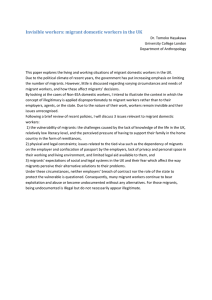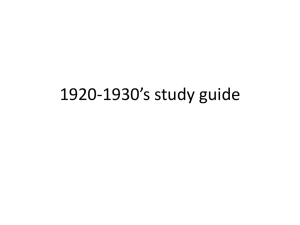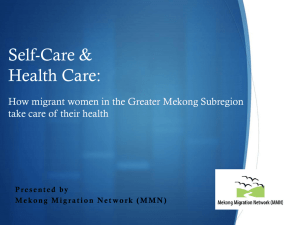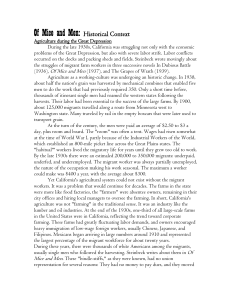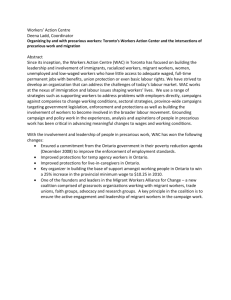Cost-Benefits
advertisement
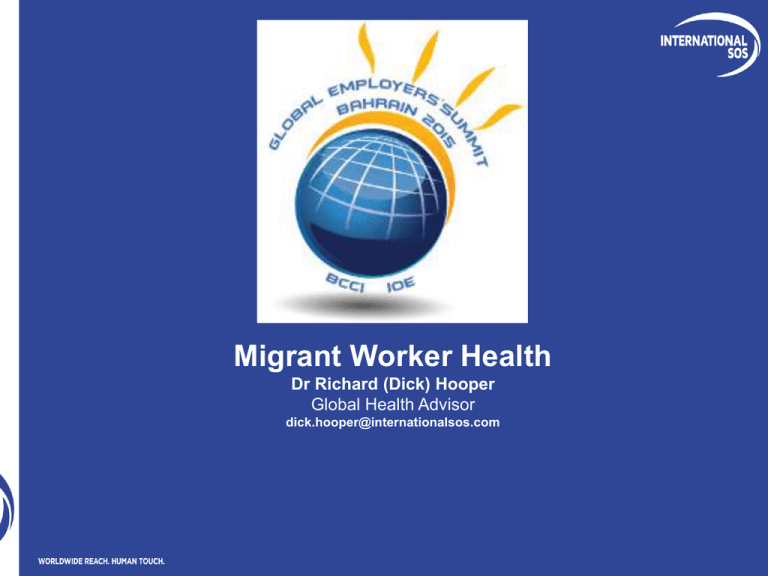
Migrant Worker Health Dr Richard (Dick) Hooper Global Health Advisor dick.hooper@internationalsos.com Agenda 2 • Spectrum of labour migrants • The case for managing the Health of Labour Migrants • Social Responsibility • Business Opportunity • Illustrative case studies • Business ‘best practice’ 3 4 COST BENEFITS OF PREVENTION Prevent conclusion: “Companies who invest in the prevention of health risks commonly experience both direct and indirect cost benefits. These should now be essential management practices for a sound business.” – Marc De Greef, Managing Director of Prevent Duty of Care Research Trinity: The trinity shows that those organisations who take measures to mitigate health and travel security risks are not only meeting their moral and legal obligations; they are also making a wise commercial investment. 5 Prevention programmes Preparing the traveller is the key element of travel risk prevention: 38% travellers suffer health impairment Impairment ranges from minor to major health issues. 14% travellers incapacitated Incapacity ranges from short to long term sick leave. The base for healthy journeys: Assessing employee health before departure. Providing sufficient supplies of medicine required by employee. Selecting vaccines. Providing information, education and training about prevention. Above: Protecting the health and safety of those who regularly travel overseas Source: Annals of the ACTM, an International journal of tropical & travel medicine 6 Cost-Benefits Pre-travel health screening Medical check programme for travellers and international assignees: $2.53 return for every $1 invested Cost-benefit analysis showed that US$1 invested returns a benefit ranging from $1.6 (minimum scenario) to US$2.53 (maximum scenario). Programme scope: Identifying pre-existing medical issues before assigning employees to a foreign country. Ensuring employees were fit-to-work for the proposed job and work conditions. Identify general and work-related health problems before departure. Source: Dr Myles Druckman and Carl Spitznagel, Measuring the benefits of global employee health assessment programmes, International SOS, 2011. 7 Cost Of Failure Expatriation & Failed Assignment Average cost of an international assignment: $311k The cost of assignments ranges somewhere between US$103,000 and $396,000. Cost of failure: $570-950k The cost of failed assignments ranges somewhere between US$570,000 and $950,000. The cost per assignee varies according to work position and status: Salary is a considerable factor. Direct costs are measured; including salary, training costs, travel and relocation expenses. Indirect costs e.g. loss of market share, reputational damage, etc. may be invisible and much more expensive than direct costs. 8 The business benefits of a healthy workforce 9 Improving Migrant Worker Welfare 10 Mapping and identifying health risks for major migration corridors in the supply chain Building health profiles for migrant workers Develop preventive health programs for migrant workers Communicate and enforce health and safety standards Pro-actively ensure availability, accessibility and acceptability and quality of health services 11 Health issues at each phase of migration BSR Migrant Workers and Health – The Role of Business – Jan 2012 12 13 Agenda 14 • Spectrum of labour migrants • The case for managing the Health of Labour Migrants • Social Responsibility • Business Opportunity • Illustrative case studies • Business ‘best practice’
